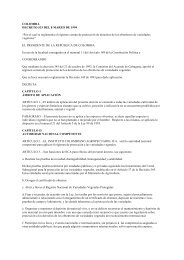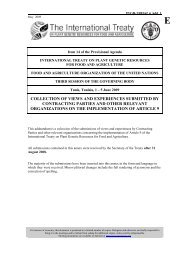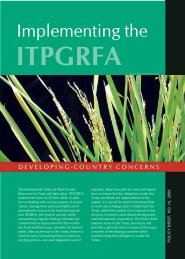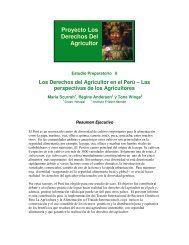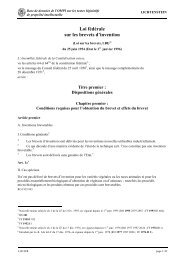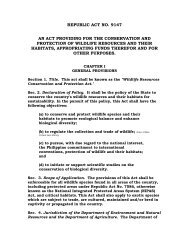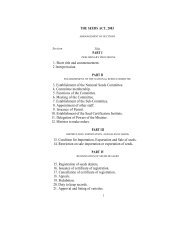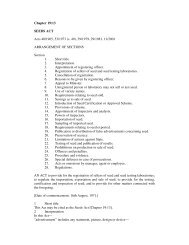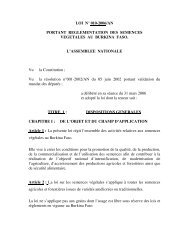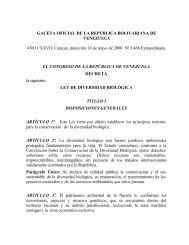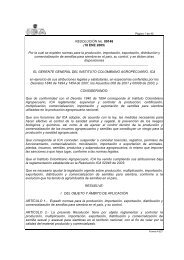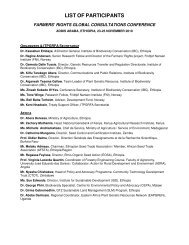Para PDF Tesis con Figuras en Word.p65 - Farmers' Rights website
Para PDF Tesis con Figuras en Word.p65 - Farmers' Rights website
Para PDF Tesis con Figuras en Word.p65 - Farmers' Rights website
You also want an ePaper? Increase the reach of your titles
YUMPU automatically turns print PDFs into web optimized ePapers that Google loves.
etwe<strong>en</strong> in-situ <strong>con</strong>servation efforts focusing on crop wild relatives and cultivated g<strong>en</strong>etic<br />
diversity relates to the inher<strong>en</strong>t anthropog<strong>en</strong>ic nature of the latter. Fundam<strong>en</strong>tally, cultivated<br />
g<strong>en</strong>etic diversity cannot be maintained in-situ without its active managem<strong>en</strong>t by man while<br />
crop wild relatives are ideally left uninterrupted without human interfer<strong>en</strong>ce (e.g. habit<br />
destruction) which would put at risk their long term survival (Heywood et al., 2007; Jarvis et al.,<br />
2008; Maxted et al., 2008). It is doubtful that <strong>con</strong>servation perse motivates most farmers to maintain<br />
high levels of potato g<strong>en</strong>etic diversity. Nevertheless, there are indications that individual farmers<br />
may accumulate and maintain diversity for “<strong>con</strong>servation” purposes. However, in g<strong>en</strong>eral, farmerdriv<strong>en</strong><br />
in-situ <strong>con</strong>servation can be se<strong>en</strong> as the outcome of livelihood strategies that actively use<br />
and rely on crop g<strong>en</strong>etic diversity (Brush, 2004).<br />
In this study, farmer-driv<strong>en</strong> in-situ <strong>con</strong>servation of potato, i.e. that which is being grown by<br />
farmers, is investigated at differ<strong>en</strong>t system levels from alleles, cultivars, and botanical species up<br />
to agroecology as well as overarching links to seed and food systems. The dim<strong>en</strong>sions of time<br />
and space are inferred upon by taking into account both annual and longer-term spatial patterns<br />
within the Andean <strong>en</strong>vironm<strong>en</strong>t. The thesis also aims to link the diversity found in farmers’ fields<br />
and its temporal-spatial distribution to a series of farmer-based drivers, such as changes in land<br />
use, and external drivers, e.g. biotic and abiotic stress and markets. Compon<strong>en</strong>ts of farmer-driv<strong>en</strong><br />
in-situ <strong>con</strong>servation are “mirrored” against each other to gain insights into their relationships,<br />
e.g. formal versus indig<strong>en</strong>ous biosystematics and in-situ versus ex-situ <strong>con</strong>servation. The study<br />
of these differ<strong>en</strong>t elem<strong>en</strong>ts of farmer-driv<strong>en</strong> in-situ <strong>con</strong>servation of the potato is multidisciplinary<br />
in its basic <strong>con</strong>ceptual approach and integrates differ<strong>en</strong>t methodologies and tools while focusing<br />
on the selected dim<strong>en</strong>sions described below.<br />
1.2.1 Inv<strong>en</strong>tory of diversity<br />
While distribution patterns of cultivated potato species are well defined (Correll, 1962; Hawkes,<br />
1990; Hawkes and Hjerting, 1989; Huaman and Spooner, 2002; Ochoa, 1990, 1999, 2003; Sauer,<br />
1993), the same is not true for the fine grained scale of cultivar diversity. Andean farmers in Peru<br />
are estimated to <strong>con</strong>serve up to 3,000 distinct native cultivars based on passport data from the<br />
world potato g<strong>en</strong>ebank held at the International Potato C<strong>en</strong>ter. However, beyond the g<strong>en</strong>eral<br />
notion that cultivar diversity is particularly high in the c<strong>en</strong>tral and southern Peruvian Andes,<br />
little is known about the <strong>con</strong>temporary distribution of infraspecific diversity within specific<br />
regions. The characterization and comparison of populations of native cultivars being maintained<br />
through farmer-driv<strong>en</strong> in-situ <strong>con</strong>servation is important in order to define the “object of<br />
<strong>con</strong>servation” (Brush et al., 1995). This is affirmed by Maxted and Hawkes (1997) wh<strong>en</strong> they point<br />
out that “as a matter of urg<strong>en</strong>cy, a chain of g<strong>en</strong>etic reserves to <strong>con</strong>serve cultivated potatoes<br />
should be established throughout the Andes in areas with high levels of g<strong>en</strong>etic diversity”.<br />
Cultivar populations in the hands of farmers in Vavilov c<strong>en</strong>ters of crop origin and diversity<br />
are commonly reported to be subject to g<strong>en</strong>etic erosion resulting in the loss of alleles (Frank et<br />
al., 2002; Harlan, 1975; Ochoa, 1975) and ongoing evolution leading to the gradual creation of<br />
new g<strong>en</strong>otypes or alleles (Altieri, 1987a, 1987b; Mann, 2004; Maxted et al., 1997; Vavilov, 1992).<br />
The occurr<strong>en</strong>ce of g<strong>en</strong>etic erosion, wh<strong>en</strong> defined as the loss of alleles and g<strong>en</strong>e complexes from<br />
in-situ populations, is g<strong>en</strong>erally difficult to substantiate because of a lack of baseline data needed<br />
for comparison over a suffici<strong>en</strong>t timeframe (Brush, 2004). Therefore relatively few studies have<br />
be<strong>en</strong> able to provide quantitative evid<strong>en</strong>ce to sustain or reject the occurr<strong>en</strong>ce of g<strong>en</strong>etic erosion<br />
(e.g. Huang et al., 2007). Differ<strong>en</strong>ces betwe<strong>en</strong> the <strong>con</strong>t<strong>en</strong>ts and structures of g<strong>en</strong>ebank collections<br />
and <strong>con</strong>temporary cultivar populations in the hands of farmers, from the same geographical<br />
origin, are little known (for an exception <strong>con</strong>cerning wild potato species see Del Rio et al., 1997).<br />
1.2.2 Farmers’ classification<br />
A better understanding of the interface betwe<strong>en</strong> researcher and farmer systems of<br />
24 Potato diversity at height: Multiple dim<strong>en</strong>sions of farmer-driv<strong>en</strong> in-situ <strong>con</strong>servation in the Andes



